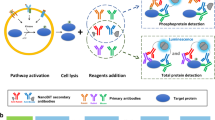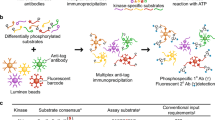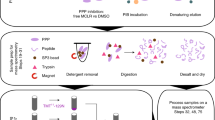Abstract
Deciphering global signaling networks is of great importance for the detailed understanding of cellular signaling processes controlling many important biological functions. Among signaling processes, tyrosine phosphorylation has a central role. At present, adequate techniques for the global characterization of the tyrosine phosphoproteome are lacking, particularly for the analysis of small amounts of protein. By combining the power of PCR amplification with the unique properties of Src homology region 2 (SH2) domains to specifically recognize tyrosine-phosphorylated proteins, we developed a new proteomic approach, termed oligonucleotide-tagged multiplex assay (OTM). For OTM, multiple SH2 domains are labeled by domain-specific oligonucleotide tags, applied as probes to complex protein mixtures in a multiplex reaction and phosphotyrosine-specific interactions are quantified by PCR. Using OTM we reproducibly quantified differential states of tyrosine phosphorylation with high sensitivity and specificity in small amounts of whole cellular extracts as demonstrated for various tumor cell lines and human leukemia samples.
This is a preview of subscription content, access via your institution
Access options
Subscribe to this journal
Receive 12 print issues and online access
$259.00 per year
only $21.58 per issue
Buy this article
- Purchase on Springer Link
- Instant access to full article PDF
Prices may be subject to local taxes which are calculated during checkout





Similar content being viewed by others
References
Hunter, T. Signaling–2000 and beyond. Cell 100, 113–127 (2000).
Ren, R. Mechanisms of BCR-ABL in the pathogenesis of chronic myelogenous leukaemia. Nat. Rev. Cancer 5, 172–183 (2005).
Hynes, N.E. & Lane, H.A. ERBB receptors and cancer: the complexity of targeted inhibitors. Nat. Rev. Cancer 5, 341–354 (2005).
Arteaga, C.L. & Baselga, J. Tyrosine kinase inhibitors: why does the current process of clinical development not apply to them? Cancer Cell 5, 525–531 (2004).
Gilliland, D.G. & Griffin, J.D. The roles of FLT3 in hematopoiesis and leukemia. Blood 100, 1532–1542 (2002).
Machida, K., Mayer, B.J. & Nollau, P. Profiling the global tyrosine phosphorylation state. Mol. Cell. Proteomics 2, 215–233 (2003).
Johnson, S.A. & Hunter, T. Kinomics: methods for deciphering the kinome. Nat. Methods 2, 17–25 (2005).
Salomon, A.R. et al. Profiling of tyrosine phosphorylation pathways in human cells using mass spectrometry. Proc. Natl. Acad. Sci. USA 100, 443–448 (2003).
Rush, J. et al. Immunoaffinity profiling of tyrosine phosphorylation in cancer cells. Nat. Biotechnol. 23, 94–101 (2005).
Blagoev, B. et al. A proteomics strategy to elucidate functional protein-protein interactions applied to EGF signaling. Nat. Biotechnol. 21, 315–318 (2003).
Tao, W.A. et al. Quantitative phosphoproteome analysis using a dendrimer conjugation chemistry and tandem mass spectrometry. Nat. Methods 2, 591–598 (2005).
Irish, J.M. et al. Single cell profiling of potentiated phospho-protein networks in cancer cells. Cell 118, 217–228 (2004).
Nollau, P. & Mayer, B.J. Profiling the global tyrosine phosphorylation state by Src homology 2 domain binding. Proc. Natl. Acad. Sci. USA 98, 13531–13536 (2001).
Pawson, T. Specificity in signal transduction: from phosphotyrosine-SH2 domain interactions to complex cellular systems. Cell 116, 191–203 (2004).
Liu, B.A. et al. The Human and Mouse Complement of SH2 Domain Proteins-Establishing the Boundaries of Phosphotyrosine Signaling. Mol. Cell 22, 851–868 (2006).
Jones, R.B., Gordus, A., Krall, J.A. & Macbeath, G. A quantitative protein interaction network for the ErbB receptors using protein microarrays. Nature 439, 168–174 (2006).
Stagljar, I. Finding partners: emerging protein interaction technologies applied to signaling networks. Sci. STKE 2003, pe56 (2003).
Papin, J.A., Hunter, T., Palsson, B.O. & Subramaniam, S. Reconstruction of cellular signalling networks and analysis of their properties. Nat. Rev. Mol. Cell Biol. 6, 99–111 (2005).
Yaffe, M.B. Phosphotyrosine-binding domains in signal transduction. Nat. Rev. Mol. Cell Biol. 3, 177–186 (2002).
Sano, T., Smith, C.L. & Cantor, C.R. Immuno-PCR: very sensitive antigen detection by means of specific antibody-DNA conjugates. Science 258, 120–122 (1992).
Niemeyer, C.M., Adler, M. & Wacker, R. Immuno-PCR: high sensitivity detection of proteins by nucleic acid amplification. Trends Biotechnol. 23, 208–216 (2005).
Hunter, T. Protein modification: phosphorylation on tyrosine residues. Curr. Opin. Cell Biol. 1, 1168–1181 (1989).
Mayer, B.J., Jackson, P.K. & Baltimore, D. The noncatalytic src homology region 2 segment of abl tyrosine kinase binds to tyrosine-phosphorylated cellular proteins with high affinity. Proc. Natl. Acad. Sci. USA 88, 627–631 (1991).
Acknowledgements
This work was supported by the Erich und Gertrud Roggenbuck-Stiftung, Hamburg, Germany (to P.N). Assay development was supported by the US National Institutes of Health grant CA107785 given to B.J.M. and P.N.; J.T. was supported by the Deutsche Forschungsgemeinschaft (SFB470). The authors gratefully acknowledge the support of C. Wagener (University Medical Center Hamburg-Eppendorf). We are very thankful to A. Hansen and B. Klampe for technical assistance, U. zur Stadt and E. Groh (University Medical Center Hamburg-Eppendorf) for access and assistance with the Light Cycler Instrument and H. Pospisil (University Hamburg) for help with the statistical evaluation. We are particularly grateful to H. Sander for assistance during analysis of patient samples.
Author information
Authors and Affiliations
Contributions
K.M., generation of SH2 probes; A.V., functional testing of SH2 probes; J.T., atomic force microscopy; M.H., data analyses and statistical evaluation; W.F., investigations on clinical samples; B.J.M., assay development and evaluation.
Corresponding author
Ethics declarations
Competing interests
The authors declare no competing financial interests.
Supplementary information
Supplementary Fig. 1
Comparable efficiency of PCR amplification of the five oligonucleotide tags. (PDF 132 kb)
Supplementary Fig. 2
Validation of PCR-ELISA. (PDF 75 kb)
Supplementary Fig. 3
Characterization of OTM probes. (PDF 682 kb)
Supplementary Fig. 4
Confirmation of results of PCR-ELISA by quantitative real-time PCR. (PDF 137 kb)
Supplementary Table 1
List of oligonucleotides. (PDF 34 kb)
Supplementary Table 2
Patient characteristics. (PDF 34 kb)
Supplementary Data
Statistical evaluation of OTM data. (PDF 70 kb)
Rights and permissions
About this article
Cite this article
Dierck, K., Machida, K., Voigt, A. et al. Quantitative multiplexed profiling of cellular signaling networks using phosphotyrosine-specific DNA-tagged SH2 domains. Nat Methods 3, 737–744 (2006). https://doi.org/10.1038/nmeth917
Received:
Accepted:
Published:
Issue Date:
DOI: https://doi.org/10.1038/nmeth917
This article is cited by
-
SH2-PLA: a sensitive in-solution approach for quantification of modular domain binding by proximity ligation and real-time PCR
BMC Biotechnology (2015)
-
SRC Homology 2 Domain Binding Sites in Insulin, IGF-1 and FGF receptor mediated signaling networks reveal an extensive potential interactome
Cell Communication and Signaling (2012)
-
Phosphotyrosine recognition domains: the typical, the atypical and the versatile
Cell Communication and Signaling (2012)
-
Towards mimicking short linear peptide motifs: identification of new mixed α,β-peptidomimetic ligands for SLAM-Associated Protein (SAP) by confocal on-bead screening
Journal of Chemical Biology (2012)



